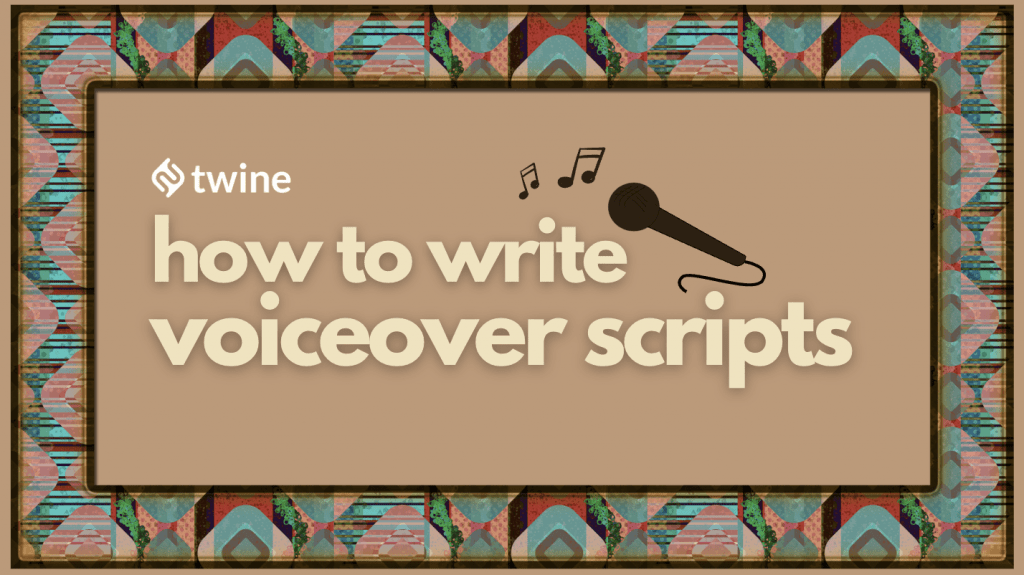
For more Creative Tools, check out the Business Toolkit…
If you want to create a memorable explainer video or another type of production, skillful directing and stunning visuals are only half the equation. And the other half? Knowing how to write great voiceover scripts.
Here we’ll look at five steps for improving your voiceover scripts, from brainstorming to hiring freelance talent.
And… action!
Get clear on the purpose of your script
Whether you’re writing voiceover scripts yourself or handing it off to a writer, getting clear on a few things first will make your job a lot easier. Here’s what to consider before you jump in:
What kind of production is it? Is it an animated explainer, YouTube video, online course, documentary, or presentation? To make things easier during the brainstorming session (and when working with freelancers), round up a few examples of the type of production you’re going for.
If you’re producing a video, consider whether you’ll need to create a storyboard and a time-coded transcript to sync to the video. A transcript is also necessary if you want to create captions/subtitles or translate your production into other languages.
Why are you creating the production? Are you selling, informing, or entertaining? The answer to this question will help you determine what kind of content goes into your voiceover scripts. For example, explainer videos almost always have a call to action, and commercial voiceover scripts often have a tagline.
How many words will your voiceover script include? This depends on the type of production you’re creating as well as your goals or preferences. As an example, animated explainer videos should range from 60 to 90 minutes in length, or 2 minutes max. Keep in mind that a professional voice actor usually reads around 150 words per minute at a comfortable pace, and calculate accordingly.
Write for your target demographic
Now that we’ve looked at the what, the why, and the how, let’s give the “who” the special attention it deserves.
There are two “whos” to consider here.
The first is your target audience. When crafting your message, you’ll want to consider factors like age, gender, job title, interests, income level, and location.
If you’re not completely clear on your target demographic (for example, if you’re creating a podcast for a relatively new blog), you can glean a lot of this information from Google Analytics.
Outlining your listener profile will help you choose the right language, tone, and messaging for your production. You’ll also need to decide whether your narrator will speak in the first, second, or third person. Once you’ve decided on everything, your task is to keep it consistent throughout your script.
Avoid, for example, bouncing back and forth between contractions (can’t, won’t, etc.) and formal speech (cannot, will not, etc.). Lapses in tone are jarring for your readers and detrimental to the believability of the voiceover scripts.
The second “who” is the person narrating your script: What is their relationship to your audience? Are they a shrewd business executive, a fellow student, a charming grandfatherly figure?
(Tip: Working with a professional voice actor who specializes in the voice of your ideal narrator is the best way to enhance your production’s credibility.)
Once you know your audience and your narrator, you can proceed to the next step: writing voiceover scripts.
Think like a copywriter
If the objective of your production is to sell, stop thinking like a director for a minute and start thinking like a copywriter:
Start with a hook. The best examples of how to write a hook can be found within YouTube ads – the ones worth their salt, anyway. This is because advertisers have an incentive to get to the point quickly: After the first 5 seconds, viewers can click away if they’re not interested.
Emphasize benefits over features. Features are technical or descriptive in nature, while benefits often target an emotional need.
Offer proof for your claims. For instance, you can cite research, how many customers you have, or demonstrate how your product stacks up against the competition.
Include a call to action. Typical CTAs include dialing a number, booking a free consultation, signing up for a free trial, or making a purchase.
Write in the active voice, not the passive voice. The active voice is direct and concise, which is exactly what you’re after when you want someone to buy something.
Add some space
In the same way that whitespace on a page makes text easier to read, pauses or “beats” in a voiceover make it easier to process, not to mention more natural sounding and engaging, for your listeners. Allowing space for breathing can also prevent your real-life voice actor from dying by asphyxiation.
On that note, don’t assume that your voice actor will know where to pause for maximum effect. Write it into the script using commas, double line breaks, or ellipses.
If you’re creating a video production, let the visuals step in and do some of the heavy liftings. If you’re working with audio only, consider adding in some non-intrusive background music to pull it all together.
Test drive your voiceover script
Congratulations on completing the initial draft! Now comes the editing phase.
Start by reading your script out loud to yourself and note down any phrases that sound awkward or that are difficult to read without stumbling. If possible, also read your script to one or more others and ask for feedback on how everything sounds.
If your script will be set to background music, now is a good opportunity to read your script aloud with the background music to ensure the mood of the music matches the tone of your script. Your music shouldn’t interfere with the voiceover – this especially applies when choosing music for explainer videos.
If this is the first script you’ve ever written, don’t expect to nail it on the first try. If something doesn’t sound quite right, take it back to the drawing board and try again. Edit ruthlessly, and whittle it down until the script flows. (Or save yourself the hassle and hire a professional script writer.)
Hiring and working with voiceover talent
Writing, narrating, and recording a voiceover are skills that take time to develop and master. If you’re after the best possible results, consider hiring professional talent to take care of everything for you.
A skilled voiceover script writer and/or animator can put together a compelling, cohesive story, and a professional voice actor can take it to the next level by making it believable.
Ultimately, this is your production and you’re the director. Even the best script writers and voice actors can’t be expected to read your mind, so you’ll need to create a detailed brief to get the most out of your production. When you post your voiceover job on Twine, not only will the team help you write your brief, but you don’t have to pay until you find the right freelancer for your project.
Or, browse video and animation freelancers and find the perfect match for your production today.
Ready to hire? Our marketplace of over 410,000 diverse freelancers has the skills and expertise needed to skyrocket your business. From marketers to designers, copywriters to SEO experts – browse the talented bunch here!



